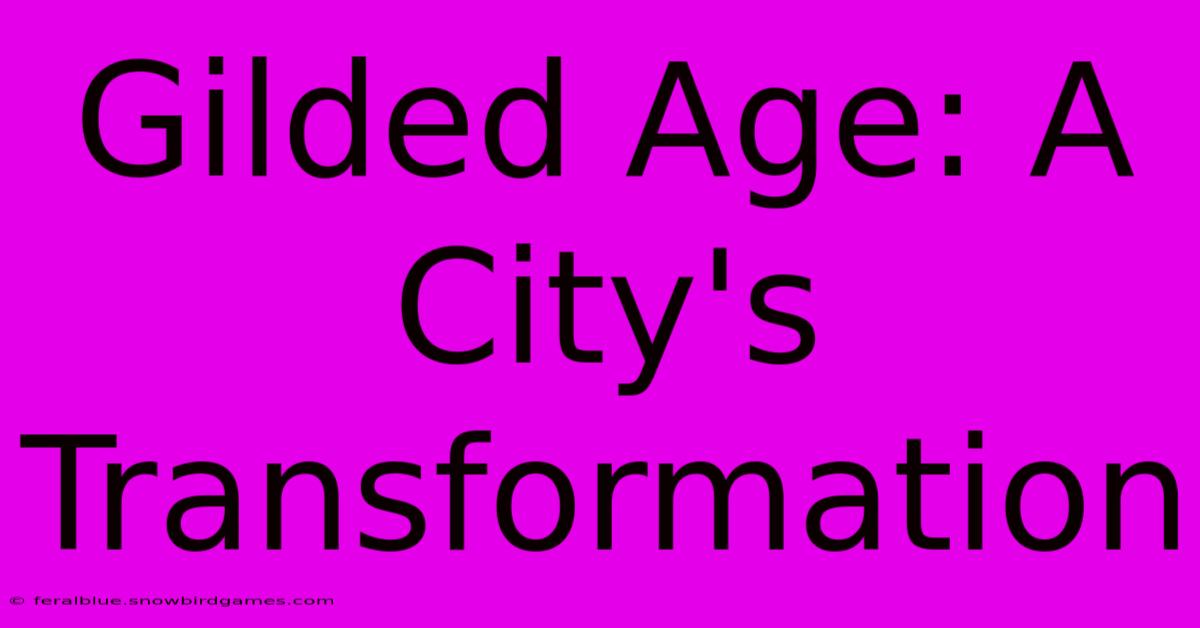Gilded Age: A City's Transformation

Table of Contents
Gilded Age: A City's Transformation
The Gilded Age, spanning roughly from the 1870s to the 1890s, represents a period of immense transformation for American cities. Fueled by industrialization, rapid population growth, and unprecedented wealth, cities across the nation underwent dramatic changes, leaving an indelible mark on the American landscape. This article will explore the key aspects of this urban metamorphosis, focusing on the challenges and triumphs that defined the Gilded Age city.
The Rise of Industrial Powerhouses
The Gilded Age was synonymous with industrial boom. Steel, railroads, and factories became the cornerstones of the economy, attracting millions of immigrants and rural migrants seeking employment. Cities like New York, Chicago, and Pittsburgh emerged as industrial powerhouses, their skylines punctuated by sprawling factories and towering skyscrapers. This rapid industrial growth fundamentally reshaped the urban landscape, creating both opportunities and significant problems.
The Impact of Industrialization:
- Job Creation: Factories offered jobs, albeit often under harsh conditions, attracting a diverse workforce.
- Urban Sprawl: Cities expanded rapidly, leading to unplanned growth and inadequate infrastructure.
- Pollution: Industrial activity resulted in severe air and water pollution, impacting public health.
- Wealth Disparity: While industrialists amassed immense fortunes, many workers struggled with poverty and inequality.
The Changing Urban Fabric: Skyscrapers and Slums
The Gilded Age witnessed the construction of the first skyscrapers, symbolizing both technological advancement and the concentration of wealth. These towering structures dramatically altered city skylines, transforming the physical environment. However, this era of progress coexisted with stark poverty. Tenement buildings, overcrowded and unsanitary, became the homes of millions of working-class families, highlighting the immense social inequalities of the time.
A Tale of Two Cities:
- Skyscrapers: Innovative architecture reflecting technological advancement and the power of big business. Examples include the Wainwright Building in St. Louis and the Flatiron Building in New York City.
- Tenements: Overcrowded, disease-ridden housing reflecting the plight of the working poor. These conditions contributed to high rates of disease and mortality.
Immigration and the Melting Pot
The Gilded Age saw unprecedented waves of immigration, primarily from Europe. Immigrants poured into American cities, seeking better lives and contributing significantly to the growth of the industrial workforce. This influx of people from diverse backgrounds led to the development of vibrant ethnic enclaves, while also creating challenges related to assimilation and social tensions.
Navigating a New World:
- Ethnic Enclaves: Immigrants often settled in neighborhoods with others from their home countries, creating supportive communities.
- Cultural Diversity: The influx of immigrants enriched American culture, but also resulted in cultural clashes and prejudice.
- Assimilation Challenges: Immigrants faced pressure to assimilate into American society, often losing aspects of their cultural heritage.
Political Corruption and Reform Movements
The rapid growth and wealth of the Gilded Age were also accompanied by widespread political corruption. Powerful political machines controlled city governments, often engaging in graft and bribery. However, this era also saw the rise of reform movements, advocating for better living conditions, improved public services, and greater political accountability.
Fighting for Change:
- Political Machines: Organizations that controlled city politics through patronage and corruption. Examples include Tammany Hall in New York City.
- Reform Movements: Groups advocating for social justice, improved sanitation, and political transparency. These movements laid the groundwork for future progressive reforms.
Legacy of the Gilded Age City
The Gilded Age left a lasting legacy on American cities. The physical landscape was transformed by skyscrapers and sprawling infrastructure, while social and political structures were fundamentally altered. The era's challenges, including poverty, inequality, and corruption, spurred important reforms that shaped the future of urban America. Understanding the Gilded Age is crucial to comprehending the complexities of modern American cities and the ongoing struggle for social justice and equitable urban development. The lessons learned from this transformative period continue to resonate today.

Thank you for visiting our website wich cover about Gilded Age: A City's Transformation. We hope the information provided has been useful to you. Feel free to contact us if you have any questions or need further assistance. See you next time and dont miss to bookmark.
Featured Posts
-
Bhad Bhabies Rise To Riches A Net Worth Analysis
Apr 07, 2025
-
Rohit Sharmas Daughter A Precious Gift To The Family
Apr 07, 2025
-
Ravindra Jadeja Age Experience Vs Youth
Apr 07, 2025
-
Ms Dhonis Net Worth Impact On Indian Economy
Apr 07, 2025
-
Dads Epic Life A Story Worth Sharing
Apr 07, 2025
